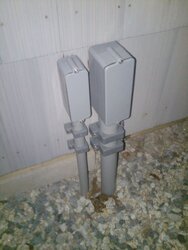I just set the 100 amp siemens subpanel in my new barn this weekend. My setup goes like this:
1) 200 amp house panel, 60 amp breaker for barn.
2) 6/3 with ground romex to the outside wall of the house.
3) Transition to 1.5" conduit with THWN-2, same wire sizes and copper.
4) 24" cover over conduit underground to barn.
5) Conduit through slab to base of subpanel and into the 100 amp breaker of the subpanel(acts as a disconnect).
I put in two ground rods at the subpanel and tied them to the ground bar of the subpanel with #4 bare copper.
On the subpanel I removed the tie bar connecting the neutral and ground bars. I drove in the green screw which ties the ground bar to the panel.
1) Do I run the 10 gauge THWN ground wire from the house to the neutral bar or the ground bar in the subpanel? I assume ground bar but then the neutral will be bonded via the house panel.
2) Where the conduit ends at the house I used a 30 cubic inch LB. I made my splice inside the LB using wirenuts. I've never wire nutted #6 wires and I'm not real happy with how they work. Is this standard practice?
3) The LB is against the house with the back opening poking through the siding to the inside. Regular wirenuts okay or need I use those silicone filled ones? Is there a better connector for this that is more secure than a wirenut?
4) The 6/3 romex just enters the back of the LB. It is not clamped to the LB in any way. I can see into the LB and see the wirenuts through the big 1.5" opening. Is this okay? How close to the LB must my last staple be?
I will be getting a permit for this but our state inspectors don't answer questions, they just show up and approve/fail.
Thanks for your help folks. Before inspection I will be installing the lighting and outlet circuits. When you buy a permit here the single permit covers the subpanel plus five circuits so I want them installed before inspection.
1) 200 amp house panel, 60 amp breaker for barn.
2) 6/3 with ground romex to the outside wall of the house.
3) Transition to 1.5" conduit with THWN-2, same wire sizes and copper.
4) 24" cover over conduit underground to barn.
5) Conduit through slab to base of subpanel and into the 100 amp breaker of the subpanel(acts as a disconnect).
I put in two ground rods at the subpanel and tied them to the ground bar of the subpanel with #4 bare copper.
On the subpanel I removed the tie bar connecting the neutral and ground bars. I drove in the green screw which ties the ground bar to the panel.
1) Do I run the 10 gauge THWN ground wire from the house to the neutral bar or the ground bar in the subpanel? I assume ground bar but then the neutral will be bonded via the house panel.
2) Where the conduit ends at the house I used a 30 cubic inch LB. I made my splice inside the LB using wirenuts. I've never wire nutted #6 wires and I'm not real happy with how they work. Is this standard practice?
3) The LB is against the house with the back opening poking through the siding to the inside. Regular wirenuts okay or need I use those silicone filled ones? Is there a better connector for this that is more secure than a wirenut?
4) The 6/3 romex just enters the back of the LB. It is not clamped to the LB in any way. I can see into the LB and see the wirenuts through the big 1.5" opening. Is this okay? How close to the LB must my last staple be?
I will be getting a permit for this but our state inspectors don't answer questions, they just show up and approve/fail.
Thanks for your help folks. Before inspection I will be installing the lighting and outlet circuits. When you buy a permit here the single permit covers the subpanel plus five circuits so I want them installed before inspection.



 I used 95 feet all together.
I used 95 feet all together.